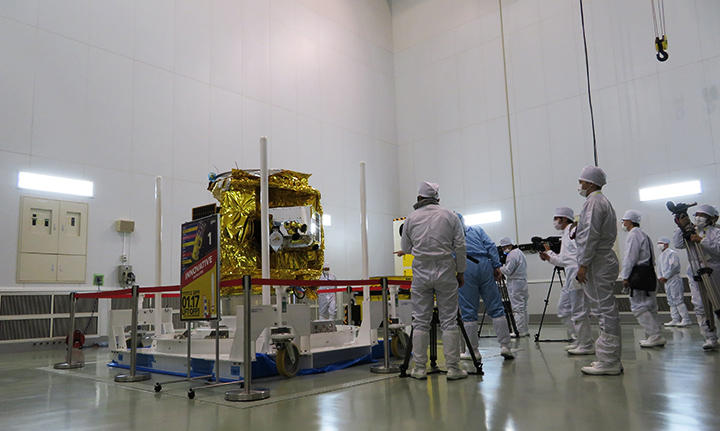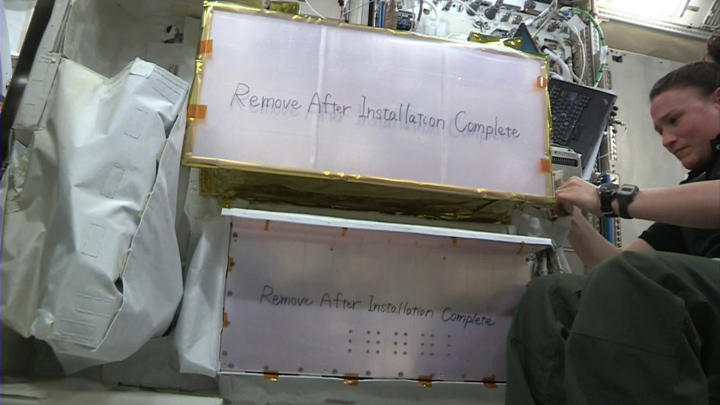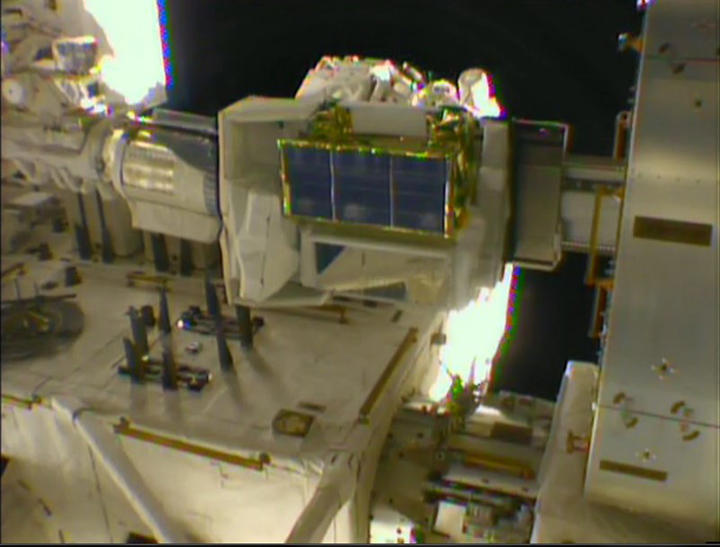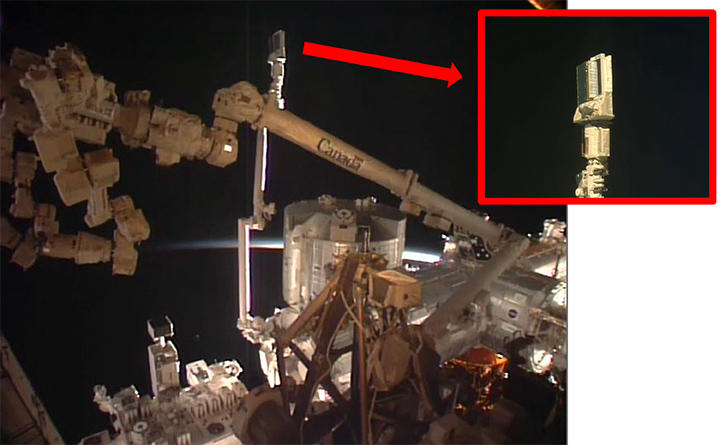Speech Abstracts by Hiroshi Yamakawa, President of JAXA
Date and time: From 1:30 - 2:30 p.m. on December 14 (Fri), 2018
Venue: JAXA Tokyo Office Presentation Room (B1 floor)
MC: Akiko Suzuki, Director, Public Affairs Department
The Innovative Satellite Technology Demonstartion-1 Launch aboard Epsilon-4
On January 17, 2019, the Innovative Satellite Technology Demonstartion-1 will launch aboard the fourth Epsilon Launch Vehicle from the JAXA Uchinoura Space Center. This will be the final flagship launch of this fiscal year and the first launch under the law for licensing the launching of rockets and the operation of satellites, as known as the Space Activities Act, enacted on November 15, 2018. In compliance with the Space Act, JAXA has had the Epsilon-4 launch authorized and has obtained the certificate of conformity. The launch facility has met the compliance regulation and been approved of.
The Innovative Satellite Technology Demonstartion-1 is a suit of seven small satellite missions to demonstrate innovative new technological approaches, consisting of the Rapid Innovative Payload Demonstration Satellite 1 (RAPIS-1) and two pairs of three small satellites and CubeSats. Yesterday they were shown to the media.
Axelspace Corporation, a space startup develops, tests and operates the RAPIS-1, which employs different development methods from JAXA's satellites. Their approach maximizes the use of instruments that have already been manufactured as part of small satellites and other spacecraft in operation, to seek to shorten the development time and reduce costs. Operation of the satellites, too, will be done by Axelspace from their own ground system.

Image: The Innovative Satellite Technology Demonstartion-1 as Shown to the Media, the JAXA Uchinoura Space Center
As mentioned at the press conference last September, the innovative payload demonstration program accepts applications of individual parts to be built in a satellite with technological support by JAXA for orbital technology demonstration. It presents one of the few opportunities for developers of parts as well as complete satellites to have their innovative technology and ideas demonstrated on orbit.
Seven instruments aboard RAPIS-1 are, one part and six components. This embodies technology demonstrations of satellite propulsion, equipment that mechanically extends, and individual electronic parts – categories which have hardly been demonstrated by H-IIA piggyback launch.
On 18, a press briefing is held at the JAXA Tokyo Office to describe the demonstration themes of each of the seven instruments aboard RAPIS-1. There, Microsoft HoloLends, produced by Microsoft will present the mixed reality (MR) images of RAPIS-1 in the actual size, parts, components, their deployment plan and functions. The presentation is designed to help attendees instinctively feel the RAPIS-1 structure, especially the mechanism inside it, which is otherwise impossible to look at. JAXA is pleased with your attendance.
Shikisai off to Operational Phase, Starts Data Provision
Following the December 23, 2017 launch, Shikisai, Global Change Observing Mission-Climate, (GCOM-C) completed its almost a year-long initial in-orbit checkout and calibration and validation phase today.
The monitoring wavelengths of the Shikisai satellite ranges from near ultraviolet to thermal infrared, including 19 spectra. This feature allows the satellite to perform polarimetric measuring, both forward and backward pointing observations and monitoring at red and near infrared wavelengths. Shikisai's observation swath of over 1,000 kilometers at 250-meter spatial resolution covers the entire Earth in two days. Shikisai provides data of clouds, aerosols, vegetation, essential to improve projection of global warming. The satellite also provides dataset about fishing spots, Asian Dust and algae blooms, helping many to better understand and cope with the environment.
On Thursday, December 20, we will hold a briefing where the results of Shikisai observation data verification will be presented. JAXA also explains the service that publishes the data. Your attendance would be cordially welcomed.
KIBO In-Orbit LHP Radiator Experiment
Japanese space policy's mid- and long-term goal stipulates expanding the share by the private sector in the world's commercial satellite communication market in the 2020's. The Engineering Test Satellite No. 9 is being developed to realize the goal.
One roadblock is that next generation geostationary satellites which have electronic propulsion and high electronic communication systems need high thermal control system. But the conventional thermal technology which depends on heat radiating fins to dissipate excess heat would not be enough.
The Loop Heat Pipe (LHP) is an advanced heat transfer device that utilizes the evaporative latent heat to circulate the fluid.
Conventionally, a big radiator has had to be installed to generate enough electricity, resulting in traditional large satellites.
However, a satellite is subject to a size restriction so as to be housed in the fairing of a launch vehicle.
JAXA is undertaking the technical challenge to make the LHP radiator deployable after launch, which would exponentially increase the heat transfer performance and functions.
At the Japanese Experiment Module (JEM) External Facility of the International Space Station, (ISS) the LHP investigation was conducted almost for a month on October 22 to November 16, 2018, under microgravity conditions using the LHP experimental apparatus.
This was a preliminary experiment to the LHP technological demonstration, to be installed to the Engineering Test Satellite No. 9.
The results go as follows;
On September 23, 2018, the LHP experimental apparatus was transported aboard HTV7 to the ISS, grappled by the JEM Remote Manipulator System (JEMRMS), and loaded onto the Multi-Purpose Experiment Platform (MPEP). While the LHP was on the MPEP platform, grappled by the JEMRMS, data was acquired on the LHP operational status and the microgravity effect on the thermal transfer.

Image: The LHP experimental apparatus attached to the MPEP at the JEM

Image: The MPEP platform is then attached to the JEM Slide Table inside the JEM airlock for transfer to the JEMRMS and space environment

Image: The apparatus as grappled by the JEMRMS at the JEM External Facility
The results were that the LHP operations under microgravity condition proceeded well, including the manual power on/off control which functions to circulate/stop the working fluid on orbit. The data also confirmed that the operating temperature of the working fluid to be used to transfer heat can be controlled within the target temperature range of ±0.5 degrees Celsius. These experiment results are to be applied to the Engineering Test Satellite No. 9, of which the specifications of satellite systems, subsystems and components are being designed. To be more specific, JAXA is performing tests on the breadboard model (BBM) to evaluate the functions and producing the engineering model (EM).
RFP for Kibo Commercial Service Providers
JAXA seeks to expand the use of Kibo, the Japanese Experiment Module of the ISS by opening some part of the Module for private businesses and others. Under this commercial service initiative, based on JAXA's "Kibo Utilization Strategy", enacted in August 2017, private companies can autonomously pursuit their businesses at the allocated area within Kibo.
As announce earlier, JAXA selected Space BD and Mitsui & Co., Ltd. as commercial service providers for the first round of the Request for Proposal (RFP). Space BD announced that the company received the first launch and deployment contract of a small satellite. Business operations are in full swing at both companies to prepare for the deployments of a few satellites during the next fiscal year.
Starting this month, JAXA issued the second RFP for still more commercial providers, particularly those who desire to facilitate the unique equipment only on Kibo –, the integrated operation of the robotics arm and the airlock, and the IVA-replaceable Small Exposed Experiment Platform (i-SEEP), a hardware adapter developed by JAXA.
i-SEEP, much like a bus within a satellite, provides the experimental equipment developed by users with infrastructure – electricity, image, data communication, and heat exhaust. This will enable them to concentrate on their missions for instance, technical demonstration of new sensors and filming Earth with an off-the-shelf camera at the Kibo extravehicular platform.
Applications are accepted for the second RFP until January 31, 2019. Selected private providers will be contracted for six years, until December 31, 2024.
JAXA hopes this initiative will increase the demand for Kibo and other extravehicular operations of the ISS. In the beginning of the next fiscal year, SONY Computer Science Laboratory, Inc. will demonstrate the laser communications technology, under the first fee-based contract with JAXA.